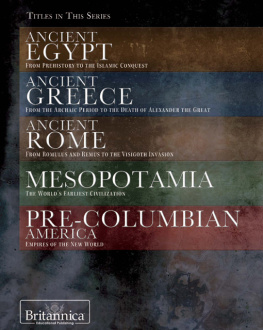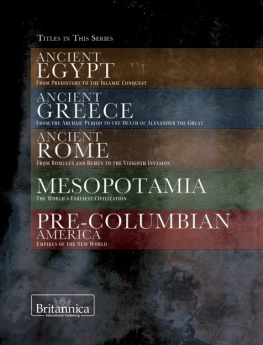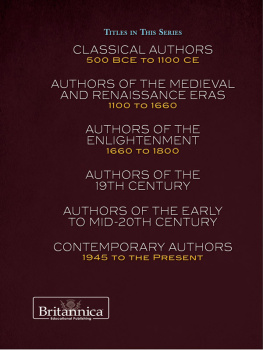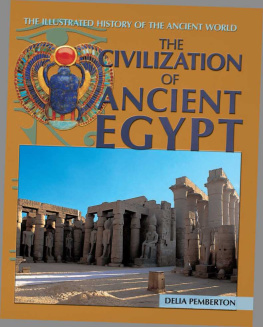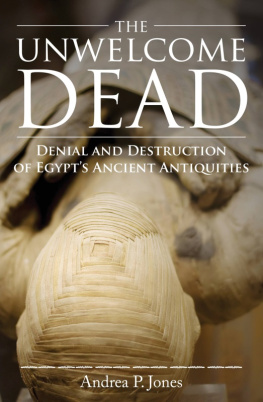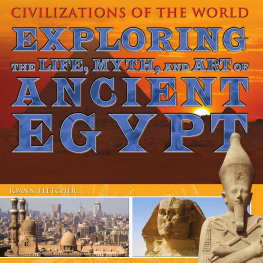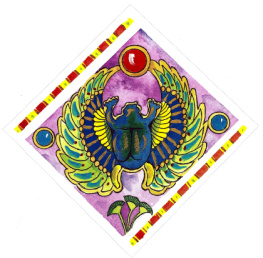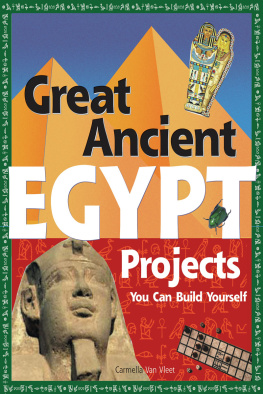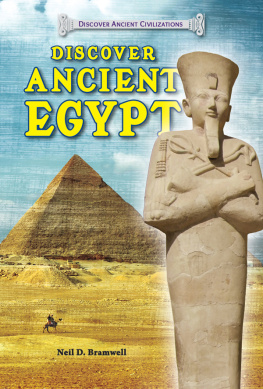ANCIENT EGYPT
FROM PREHISTORY TO THE ISLAMIC CONQUEST
THE BRITANNICA GUIDE TO ANCIENT CIVILIZATIONS
ANCIENT EGYPT
FROM PREHISTORY TO THE ISLAMIC CONQUEST
EDITED BY KATHLEEN KUIPER, MANAGER, ARTS AND CULTURE

Published in 2011 by Britannica Educational Publishing
(a trademark of Encyclopdia Britannica, Inc.)
in association with Rosen Educational Services, LLC
29 East 21st Street, New York, NY 10010.
Copyright 2011 Encyclopdia Britannica, Inc. Britannica, Encyclopdia Britannica, and the Thistle logo are registered trademarks of Encyclopdia Britannica, Inc. All rights reserved.
Rosen Educational Services materials copyright 2011 Rosen Educational Services, LLC. All rights reserved.
Distributed exclusively by Rosen Educational Services. For a listing of additional Britannica Educational Publishing titles, call toll free (800) 237-9932.
First Edition
Britannica Educational Publishing
Michael I. Levy: Executive Editor
J.E. Luebering: Senior Manager
Marilyn L. Barton: Senior Coordinator, Production Control
Steven Bosco: Director, Editorial Technologies
Lisa S. Braucher: Senior Producer and Data Editor
Yvette Charboneau: Senior Copy Editor
Kathy Nakamura: Manager, Media Acquisition
Kathleen Kuiper: Manager, Arts and Culture
Rosen Educational Services
Jeanne Nagle: Senior Editor
Nelson S: Art Director
Cindy Reiman: Photography Manager
Matthew Cauli: Designer, Cover Design
Introduction by Sean Price
Library of Congress Cataloging-in-Publication Data
Ancient Egypt : from prehistory to the Islamic conquest / edited by Kathleen Kuiper. 1st ed.
p. cm. (The Britannica guide to ancient civilizations)
In association with Britannica Educational Publishing, Rosen Educational Services.
Includes bibliographical references and index.
ISBN 978-1-61530-210-9 (ebook)
1. EgyptCivilizationTo 332 B.C. 2. EgyptSocial life and customsTo 332 B.C. 3.
EgyptCivilization332 B.C.-638 A.D. 4. Egypt--Social life and customs. I. Kuiper,
Kathleen.
DT61.A612 2010
932dc22
2010008661
On the cover:A golden image of the boy king Tutankhamen, provided by his funerary
mask. Romilly Lockyer/The Image Bank/Getty Images
On pages : DEA/C. Sappa/De Agostini/Getty Images
INTRODUCTION

King Akhenaton and Queen Nefertiti worship the sun god Aton. Hulton Archive/Getty Images
I t can be said that the story of ancient Egypt begins with the Nile River. Settlements along the Nile existed at least 2,000 years before Egypts first ruling dynasty was founded about 3100 BC. The earliest settlers along the Nile were nomads and pastoralists who grew barley on the fertile floodplain or fished and hunted. The Nile River basin served as the stage for the evolution and decay of an advanced civilization. The river itself enabled the descendants of these seemingly unexceptional people to build a civilization that would tower over the ancient world. This book helps explain how they did it and what it means for us today.
Early Egypt was divided geographically and culturally into Upper Egypt and Lower Egypt. Upper Egypt consisted of the region south of the Nile delta. From these highlands the mighty Nile flowed northward. Lower Egypt was made up of the northern lowlands, where the Nile ended in a fan-shaped delta that emptied into the Mediterranean Sea. Upland people tended to be fierce and rugged, like the terrain that was their home. Lowland northerners were more likely to be prosperous farmers.
Along the banks of the Nile grew the grasslike aquatic plant known as papyrus. The fibres from the stem of this versatile plant were used to make cloth for sails and clothing. Bundled together, papyrus reeds could be fashioned into boats or rope. Without a doubt, the most historically important use of papyrus was as a writing surface. To make this surface, Egyptians crushed the stems of the plant, dampened the layers they created from the strips thus obtained, and finally hammered and dried the result. About 3000 BC papyrus joined clay tablets as preferred writing surfaces. Many documents written on papyrus (the root of the English word paper) are still in existence today.
Papyrus documents have provided much of what is known about ancient Egypt, as have inscribed monuments, artwork, and various lists of kings. The most important kings list is Manethos Aegyptiaca (now lost), which offered the basic chronological structure that most historians work from today. Manetho, a priest who lived in the early 3rd century BC, divided Egyptian history, after unification in 3100 BC, into dynasties, 30 of which are recognized.
Ancient Egypt was a land ruled by kings, who were also known as pharaohs. The word pharaoh comes from the Egyptian term for great house, referring to the kings palace. Egyptians believed that their leaders were god-kings who became full-fledged gods after their deaths. The names of some 170 Egyptian kings are known.
The first recorded pharaoh was Menes, who ruled from about 3150 to 3125 BC. According to legend, Menes founded the nations capital at Memphis and united Lower Egypt and Upper Egypt. Yet the archaeological evidence for this early period is sketchy. Excavations have shown that up to two dozen rulers may have carried out the unification. One thing is clear: Egypts power, stability, and unity in the ancient world made it the first true nation-state.
Perhaps the most recognizable of the ancient Egyptian kings is Tutankhamen, a relatively minor leader in the overarching history of Egyptian rulers. The Boy King ascended to the throne in 1333 BC at a very young age and died when he was just 19. He was thrust into the limelight in 1922, when his burial site was discovered by British archaeologist Howard Carter. The funerary chamber was a treasure trove. The kings of ancient Egypt controlled enormous riches, much of which was buried with them. The solid gold inner coffin found in Tutankhamens tomb would be worth millions of dollars today, for the gold alone. The wealth that accompanied longer-lived kings to their tombs must have been staggering. Unfortunately, this supposition cannot be verified with much certainty because most of the other pharaohs tombs were looted in ancient times by grave robbers.
Occasionally, women claimed Egypts throne. The two most important of these women were Hatshepsut (14731458 BC) and Cleopatra (5130 BC). Hatsheput was the daughter of one king, Thutmose I, and the sister and wife of his successor, Thutmose II. For years she ruled jointly with Thutmose III, the young son borne to her husband by another wife, until she proclaimed herself king and adopted full titles and regalia of a (male) pharaoh. Cleopatra came to the throne after her father, then her brother, died. A strong and ambitious ruler, she alternately sought alliances with and waged war against leaders of the Roman Empire. Yet despite her adept leadership, Cleopatra is perhaps best remembered for love affairs she conducted with Julius Caesar and the Roman general Mark Antony.
These women were notable exceptions in regnal matters. Egyptian leaders were overwhelmingly male, and the throne was traditionally passed down to male heirs. By tradition, the eldest son of the pharaohs chief wife usually had the strongest claim to succeed his father. However, other sonsand other male relativescould be named pharaoh as well. On occasion, a king might select a successor based on religious oracles.
Next page



